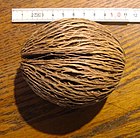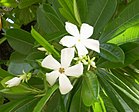Note: This is a project under development. The articles on this wiki are just being initiated and broadly incomplete. You can Help creating new pages.
Cerbera odollam - Auddalaka
Auddalaka is a small tree found along coasts in tropical countries. All parts of the tree yield a potent poison, especially the milky latex which copiously exudes from the stems.
Uses
Parts Used
Chemical Composition
Common names
| Language | Common name |
|---|---|
| Kannada | chande, chende, chende hoo |
| Hindi | dabur, pilikirbir, sukanu |
| Malayalam | otavalam, othalam, chattankaya |
| Tamil | kadalma, udalai |
| Telugu | |
| Marathi | NA |
| Gujarathi | NA |
| Punjabi | NA |
| Kashmiri | NA |
| Sanskrit | auddalakah, svanamarah |
| English | Sea Mango |
Properties
Reference: Dravya - Substance, Rasa - Taste, Guna - Qualities, Veerya - Potency, Vipaka - Post-digesion effect, Karma - Pharmacological activity, Prabhava - Therepeutics.
Dravya
Rasa
Tikta (Bitter), Katu (Pungent)
Guna
Laghu (Light), Rooksha (Dry)
Veerya
Ushna (Hot)
Vipaka
Karma
Vata
Prabhava
Habit
Identification
Leaf
| Kind | Shape | Feature |
|---|---|---|
| Simple | alternate, clustered at ends | petiole 8-35 mm long, slender, glabrous; lamina 10-25 x 2.5-6.5 cm, lanceolate or oblanceolate; base cuneate or attenuate; apex acuminate or acute; margin entire, glabrous, fleshy, bright green and shiny, membranous on drying; lateral nerves many, close, slender, parallel, looped near the margin forming intramarginal nerve; intercostae reticulate. |
Flower
| Type | Size | Color and composition | Stamen | More information |
|---|---|---|---|---|
| Bisexual | axillary spiciform racemes | Pseudoterminal cymes | White | 5 |
Fruit
| Type | Size | Mass | Appearance | Seeds | More information |
|---|---|---|---|---|---|
| A drupe | globose or ellipsoid, pericarp green turning rose; seeds 1 or 2 compressed. | {{{6}}} |
Other features
List of Ayurvedic medicine in which the herb is used
Where to get the saplings
Mode of Propagation
How to plant/cultivate
Seeds left in a bowl of warm water will start sprouting. [4]
Commonly seen growing in areas
Photo Gallery
References
External Links
Categories:
- Ayurvedic Herbs known to be helpful to treat Skin diseases
- Ayurvedic Herbs known to be helpful to treat Ringworm
- Ayurvedic Herbs known to be helpful to treat Rabies
- Herbs with Bark used in medicine
- Herbs with Fruits used in medicine
- Herbs with Leaves used in medicine
- Herbs with Latex used in medicine
- Herbs with common name in Kannada
- Herbs with common name in Hindi
- Herbs with common name in Malayalam
- Herbs with common name in Tamil
- Herbs with common name in Sanskrit
- Herbs with common name in English
- Habit - Small tree
- Index of Plants which can be propagated by Seeds
- Index of Plants which can be propagated by Cuttings
- Herbs that are commonly seen in the region of Tropical area
- Herbs that are commonly seen in the region of Coastal area
- Herbs
- Coastal area
- Tree
- Apocynaceae





